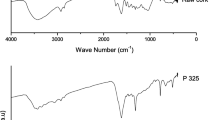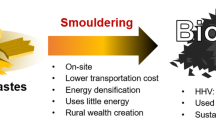Abstract
This paper assesses the feasibility of producing a metallurgical quality charcoal (biocoke) through slow high temperature pyrolysis of woody biomass. The samples used for the experiments were different types of olive wood biomass from southern Spain as well as eucalyptus trunks from Uruguay. The experiments were conducted in a two-step process: a pyrolysis semi-batch reaction at 750 °C and 3 °C/min heating rate, followed by a second step of thermal treatment at 900 °C of the pyrolysis vapours. The type of raw material used plays an important role with respect to the amount and quality of the different pyrolysis products. With the operating conditions used, high solid (24–26 wt%) and gas yields (43–54 wt%) were obtained. The solids obtained (biocoke) fulfil the requirements of good metallurgical reducers. However, leaves and bark are detrimental to biocoke quality and should be avoided. Pyrolysis gases are rich in CO and hydrogen, whereas pyrolysis liquids are mainly composed of water.



Similar content being viewed by others
References
Adrados A, Lopez-Urionabarrenechea A, Solar J, Requies J, De Marco I, Cambra JF (2013) Upgrading of pyrolysis vapours from biomass carbonization. J Anal Appl Pyrolysis 103:293–299
Adrados A, De Marco I, Lopez-Urionabarrenechea A, Solar J, Caballero B (2015) Avoiding tar formation in biocoke production from waste biomass. Biomass Bioenergy 74:172–179
Agirre I, Griessacher T, Rösler G, Antrekowitsch J (2013) Production of charcoal as an alternative reducing agent from agricultural residues using a semi-continuous semi-pilot scale pyrolysis screw reactor. Fuel Process Technol 106:114–121
Antal MJ Jr, Grønli M (2003) The art, science, and technology of charcoal production. Ind Eng Chem Res 42:1619–1640
Bai X, Kim KH, Brown RC, Dalluge E, Hutchinson C, Lee YJ, Dalluge D (2014) Formation of phenolic oligomers during fast pyrolysis of lignin. Fuel 128:170–179
Barbieri L, Andreola F, Lancellotti I, Taurino R (2013) Management of agricultural biomass waste: preliminary study on characterization and valorisation in clay matrix bricks. Waste Manage 33:2307–2315
Burhenne L, Damiani M, Aicher T (2013) Effect of feedstock water content and pyrolysis temperature on the structure and reactivity of spruce wood char produced in fixed bed pyrolysis. Fuel 107:836–847
Cao X, Zhong L, Peng X, Sun S, Li S, Liu S, Sun R (2014) Comparative study of the pyrolysis of lignocellulose and its major components: characterization and overall distribution of their biochars and volatiles. Bioresour Technol 155:21–27
Carrier M, Hardie AG, Uras Ü, Görgens J, Knoetze JH (2012) Production of char from vacuum pyrolysis of South-African sugar cane bagasse and its characterization as activated carbon and biochar. J Anal Appl Pyrolysis 96:24–32
Carrier M, Joubert J, Danje S, Hugo T, Görgens J, Knoetze J (2013) Impact of the lignocellulosic material on fast pyrolysis yields and product quality. Bioresour Technol 150:129–138
Dry ME (2002) The Fischer-Tropsch process: 1950–2000. Catal Today 71:227–241
Elyounssi K, Collard F, Mateke JN, Blin J (2012) Improvement of charcoal yield by two-step pyrolysis on eucalyptus wood: a thermogravimetric study. Fuel 96:161–167
García GB, Calero de Hoces M, Martínez García C, Cotes Palomino MT, Gálvez AR, Martín-Lara MA (2014) Characterization and modeling of pyrolysis of the two-phase olive mill solid waste. Fuel Process Technol 126:104–111
Garcia-Maraver A, Salvachúa D, Martínez MJ, Diaz LF, Zamorano M (2013) Analysis of the relation between the cellulose, hemicellulose and lignin content and the thermal behavior of residual biomass from olive trees. Waste Manage 33:2245–2249
García-Maraver A, Zamorano M, Ramos-Ridao A, Díaz LF (2011) Comparative study of cleaning methods for residues from olive tree pruning. Thirteenth International Waste Management and Landfill Symposium, Sardinia
García-Maraver A, Zamorano M, Ramos-Ridao A, Díaz LF (2012) Analysis of olive grove residual biomass potential for electric and thermal energy generation in Andalusia (Spain). Renew Sustain Energy Rev 16:745–751
Ghosh A, Chatterjee A (2008) Iron making and steelmaking: theory and practice. PHI Learning Pvt. Ltd., New Dehli
Gilbert P, Ryu C, Sharifi V, Swithenbank J (2009) Tar reduction in pyrolysis vapours from biomass over a hot char bed. Bioresour Technol 12:504–517
Gómez N, Rosas JG, Cara J, Martínez O, Alburquerque JA, Sánchez ME (2014) Slow pyrolysis of relevant biomasses in the Mediterranean basin. Part 1. Effect of temperature on process performance on a pilot scale. J Clean Prod. doi:10.1016/j.jclepro.2014.10.082
Goyal HB, Seal D, Saxena RC (2008) Bio-fuels from thermochemical conversion of renewable resources: a review. Renew Sustain Energy Rev 12:504–517
Griessacher T, Antrekowitsch J, Steinlechner S (2012) Charcoal from agricultural residues as alternative reducing agent in metal recycling. Biomass Bioenergy 39:139–146
Han J, Kim H (2008) The reduction and control technology of tar during biomass gasification/pyrolysis: an overview. Renew Sustain Energy Rev 12:397–416
Hosoya T, Kawamoto H, Saka S (2007) Cellulose–hemicellulose and cellulose–lignin interactions in wood pyrolysis at gasification temperature. J Anal Appl Pyrolysis 80:118–125
Huo W, Zhou Z, Chen X, Dai Z, Yu G (2014) Study on CO2 gasification reactivity and physical characteristics of biomass, petroleum coke and coal chars. Bioresour Technol 159:143–149
Isahak WNRW, Hisham MWM, Yarmo MA, Yun Hin T (2012) A review on bio-oil production from biomass by using pyrolysis method. Renew Sustain Energy Rev 16:5910–5923
Jones JC (2013) Letter: the BET surface areas of carbonised biomass. Fuel Process Technol 106:784
Kimura T, Miyazawa T, Nishikawa J, Kado S, Okumura K, Miyao T, Naito S, Kunimori K, Tomishige K (2006) Development of Ni catalysts for tar removal by steam gasification of biomass. Appl Catal B 68:160–170
Lee Y, Park J, Ryu C, Gang KS, Yang W, Park Y, Jung J, Hyun S (2013) Comparison of biochar properties from biomass residues produced by slow pyrolysis at 500 & #xB0;C. Bioresour Technol 148:196–201
Li L, Rowbotham JS, Greenwell CH, Dyer PW (2013) An introduction to pyrolysis and catalytic pyrolysis: versatile techniques for biomass conversion. In: New and future developments in catalysis, Elsevier; Amsterdam, pp 173–208
Liu Z, Balasubramanian R (2014) Upgrading of waste biomass by hydrothermal carbonization (HTC) and low temperature pyrolysis (LTP): a comparative evaluation. Appl Energy 114:857–864
Lu Y, Lee T (2007) Influence of the feed gas composition on the Fischer-Tropsch synthesis in commercial operations. J Nat Gas Chem 16:329–341
Lu Q, Li W, Zhu X (2009) Overview of fuel properties of biomass fast pyrolysis oils. Energy Convers Manag 50:1376–1383
Lv D, Xu M, Liu X, Zhan Z, Li Z, Yao H (2010) Effect of cellulose, lignin, alkali and alkaline earth metallic species on biomass pyrolysis and gasification. Fuel Process Technol 91:903–909
Manyà JJ, Roca FX, Perales JF (2013) TGA study examining the effect of pressure and peak temperature on biochar yield during pyrolysis of two-phase olive mill waste. J Anal Appl Pyrolysis 103:86–95
Meier D, van de Beld B, Bridgwater AV, Elliott DC, Oasmaa A, Preto F (2013) State-of-the-art of fast pyrolysis in IEA bioenergy member countries. Renew Sustain Energy Rev 20:619–641
Mészáros E, Jakab E, Várhegyi G (2007) TG/MS, Py-GC/MS and THM-GC/MS study of the composition and thermal behavior of extractive components of Robinia pseudoacacia. J Anal Appl Pyrolysis 79:61–70
Mohan D, Pittman CU Jr, Steele PH (2006) Pyrolysis of wood/biomass for bio-oil: a critical review. Energy Fuels 20:848–889
Moles MC (2008) Nutrient cycling and retention. In: Ecology, Concepts and Applications. The McGraw-Hill Companies I, New York, pp 432–449
Reichel D, Klinger M, Krzack S, Meyer B (2013) Effect of ash components on devolatilization behavior of coal in comparison with biomass—product yields, composition, and heating values. Fuel 114:64–70
Rösler G, Griessacher T, Antrekowitsch J (2012) The influence of charcoal properties on its applicability in metallurgical operations. Proc. Venice, Fourth Int. Symp. Energy from Biomass Waste
Senneca O (2007) Kinetics of pyrolysis, combustion and gasification of three biomass fuels. Fuel Process Technol 88:87–97
Shabangu S, Woolf D, Fisher EM, Angenent LT, Lehmann J (2014) Techno-economic assessment of biomass slow pyrolysis into different biochar and methanol concepts. Fuel 117(Part A):742–748
Soliño M (2010) External benefits of biomass-e in Spain: an economic valuation. Bioresour Technol 101:1992–1997
Stefanidis SD, Kalogiannis KG, Iliopoulou EF, Michailof CM, Pilavachi PA, Lappas AA (2014) A study of lignocellulosic biomass pyrolysis via the pyrolysis of cellulose, hemicellulose and lignin. J Anal Appl Pyrolysis 105:143–150
Suopajärvi H, Pongrácz E, Fabritius T (2013) The potential of using biomass-based reducing agents in the blast furnace: a review of thermochemical conversion technologies and assessments related to sustainability. Renew Sustain Energy Rev 25:511–528
Swain PK, Das LM, Naik SN (2011) Biomass to liquid: a prospective challenge to research and development in 21st century. Renew Sustain Energy Rev 15:4917–4933
Uddin MN, Daud WMAW, Abbas HF (2013) Potential hydrogen and non-condensable gases production from biomass pyrolysis: insights into the process variables. Renew Sustain Energy Rev 27:204–224
Van Zwieten L, Kimber S, Morris S, Chan KY, Downie A, Rust J, Joseph S, Cowie A (2010) Effects of biochar from slow pyrolysis of papermill waste on agronomic performance and soil fertility. Plant Soil 327:235–246
Vassilev SV, Baxter D, Vassileva CG (2013) An overview of the behaviour of biomass during combustion: part I. Phase-mineral transformations of organic and inorganic matter. Fuel 112:391–449
Wolfsmayr UJ, Rauch P (2014) The primary forest fuel supply chain: a literature review. Biomass Bioenergy 60:203–221
Woolf D, Amonette JE, Street-Perrott FA, Lehmann J, Joseph S (2010) Sustainable biochar to mitigate global climate change. Nat Commun 1:56
Xu R, Ferrante L, Hall K, Briens C, Berruti F (2011) Thermal self-sustainability of biochar production by pyrolysis. J Anal Appl Pyrolysis 91:55–66
Acknowledgments
The authors thank the University of the Basque Country (UPV/EHU) (US 11/21), the Basque Country Government (GIC 10/31, S-PE13UN126(SAI13/190)) and Programa predoctoral de formación de personal investigador no doctor, the Spanish Ministry of Science and Innovation (ENE 2011-23950) and BEFESA Steel R&D company for financial assistance for this work.
Author information
Authors and Affiliations
Corresponding author
Rights and permissions
About this article
Cite this article
Solar, J., Hernandez, A., Lopez-Urionabarrenechea, A. et al. From woody biomass waste to biocoke: influence of the proportion of different tree components. Eur. J. Wood Prod. 75, 485–497 (2017). https://doi.org/10.1007/s00107-016-1089-z
Received:
Published:
Issue Date:
DOI: https://doi.org/10.1007/s00107-016-1089-z




